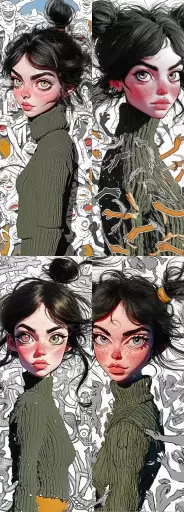Explore the Best AI Image Gallery

AI: The Artists New Brush - Exploring the Impact of AI on Graphic Design
The world of graphic design is undergoing a radical transformation, fueled by the rapid advancements in artificial intelligence (AI). This powerful technology is no longer confined to the realms of science fiction; its actively reshaping how we create, conceptualize, and interact with visual content. From generating stunning visuals to automating tedious tasks, AI is becoming an indispensable tool for designers, both novice and expert.
A New Era of Creative Possibilities
AI-powered design tools are empowering creators in unprecedented ways. Imagine a world where:
- Concept Generation: AI algorithms can analyze vast datasets of images, trends, and styles to generate diverse design concepts, sparking inspiration and overcoming creative roadblocks.
- Automated Design Tasks: Repetitive tasks such as resizing images, creating mockups, or generating basic layouts can be efficiently handled by AI, freeing up designers to focus on more strategic and creative endeavors.
- Personalized Design Experiences: AI can analyze user preferences, demographics, and context to create personalized designs that resonate with specific audiences.
Applications of AI in Graphic Design
The potential applications of AI in graphic design are vast and continually expanding. Here are just a few examples:
- Logo Design: AI-powered platforms can generate unique logo concepts based on user input, such as industry, target audience, and desired style.
- Branding and Identity Creation: AI can help develop cohesive branding systems, including color palettes, typography choices, and visual assets that align with a brands message and values.
- Marketing Materials Design: From social media graphics to website banners, AI can generate eye-catching designs tailored for specific marketing campaigns.
- Illustration and Image Generation: AI algorithms can create original illustrations, artwork, and even photorealistic images based on textual descriptions or sketches.
Ethical Considerations
While the possibilities offered by AI in graphic design are exciting, its crucial to address the ethical considerations that accompany this technology:
- Copyright and Ownership: Questions arise regarding copyright ownership when AI generates creative content. Who owns the rights to AI-generated designs?
- Bias and Representation: AI algorithms are trained on existing data, which can perpetuate biases and stereotypes. Its essential to ensure that AI-generated designs are inclusive and representative of diverse perspectives.
- Job Displacement: While AI can automate tasks, theres concern about its potential impact on the livelihoods of graphic designers. Its important to explore ways to upskill and adapt to the evolving landscape of design.
Future Trends
The future of AI in graphic design is brimming with possibilities:
- More sophisticated Generative Design: AI will continue to evolve, generating increasingly complex and nuanced designs that meet specific user needs.
- Real-time Collaboration Tools: AI-powered platforms will facilitate seamless collaboration between designers and clients, allowing for real-time feedback and iterations.
- Personalized Design Experiences: AI will enable truly personalized design experiences, tailoring visuals to individual preferences and contexts.
As AI technology advances, its impact on graphic design will be profound. Embracing these advancements while addressing the ethical considerations will be crucial for shaping a future where creativity and technology thrive in harmony.





](https://images.ai-img.art/thumbnails/150/f67d9af3398150f2ab1bcf250717fea134275e2ca896252b54a4d9bb3719f9ac.webp)



](https://images.ai-img.art/thumbnails/150/008b5d5d49667cc2e93a5f8a8adfaa545963da99c39ff0901f5296294636400d.webp)
](https://images.ai-img.art/thumbnails/150/c2c9c48b38fae37f0a457b80b084ed01ba803810fc8f488c8f610c03abc74049.webp)






](https://images.ai-img.art/thumbnails/150/bddf3ae4a232290858389b933c866ad3be429ef2e25c23a9f4d7713ed6e44d0b.webp)







](https://images.ai-img.art/thumbnails/150/4289d1230b86a96c4d556636c3167bed0ef38f850826549517e4e45db4d87bf7.webp)







](https://images.ai-img.art/thumbnails/150/f9584153b4cddd8c9fab611dc10247549b275c59bc173251e37d0935874f9deb.webp)







